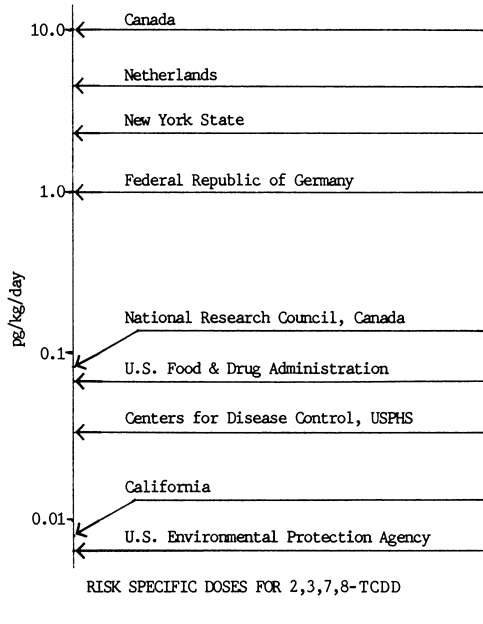

In June 1988, the Environmental Protection Agency compared the "risk specific [i.e., virtually safe] doses" calculated by individual scientists, scientific organizations and regulatory agencies in different countries for 2,3,7,8-TCDD, the most dangerous compound in the dioxin family. They found no consensus: the highest risk specific dose (RsD), for Canada, was 1,667 times higher than the lowest, which was for the EPA. In other words, the EPA saw dioxin as more dangerous than other investigators or regulators did.
That comparison of RsD figures was never published, though the figures themselves are publicly available. The values chosen by the nine regulatory agencies here and abroad are reproduced below on a log scale, to help it fit on the page. The unit of measurement is picograms (trillionths of a gram) per kilogram of body weight per day.
In the last 2 1/2 years since that comparison was drawn up, some of those values have probably changed. EPA announced in a press release last April that it would be lowering its limits still further for paper products and for sludges and effluents from paper mills. The story in the May 7 Chemical & Engineering News says this action fulfills a 1988 court-approved consent decree entered into by EPA and the Environmental Defense Fund and the National Wildlife Federation. The reason given is that fishermen who catch certain fish downstream from paper mills, and eat all their catch, might be at risk. Paper products are no longer seen as dangerous by the EPA. The story does not say whether any studies of actual fish consumers had been done.
The April press release states that "dioxin is an unwanted byproduct created by the manufacture of some chemical products, by certain combustion processes and by treating wood pulp with chlorine bleaching processes to make white paper." This does not tell the whole story. The American Paper Institute published a vague, undocumented and possibly inaccurate graph on p. 13 of the November 1989 PIMA, comparing the relative importance of various sources of dioxin. It doesn't even explicitly define "dioxin," but perhaps it can be useful as an approximate description Of the situation. It says that the pulp and paper industry accounts for 0.8%, of the dioxin released annually in U.S. The sources that are said to release more than that are:
Municipal solid waste - Incineration 60.3%
Fuel combustion 15.4%
Secondary copper furnaces 11.2%
Forest fires 4.5%
Publicly owned treatment works 2.6%
Magnesium production 2.4%
Hospital incineration 1.4%.
Industrial & hazardous waste incineration 0.8%
